Australia’s Historic Manly Swimming Club Celebrates 100 Years of Olympic Dreams – To Paris And Back From 1924 to 2024
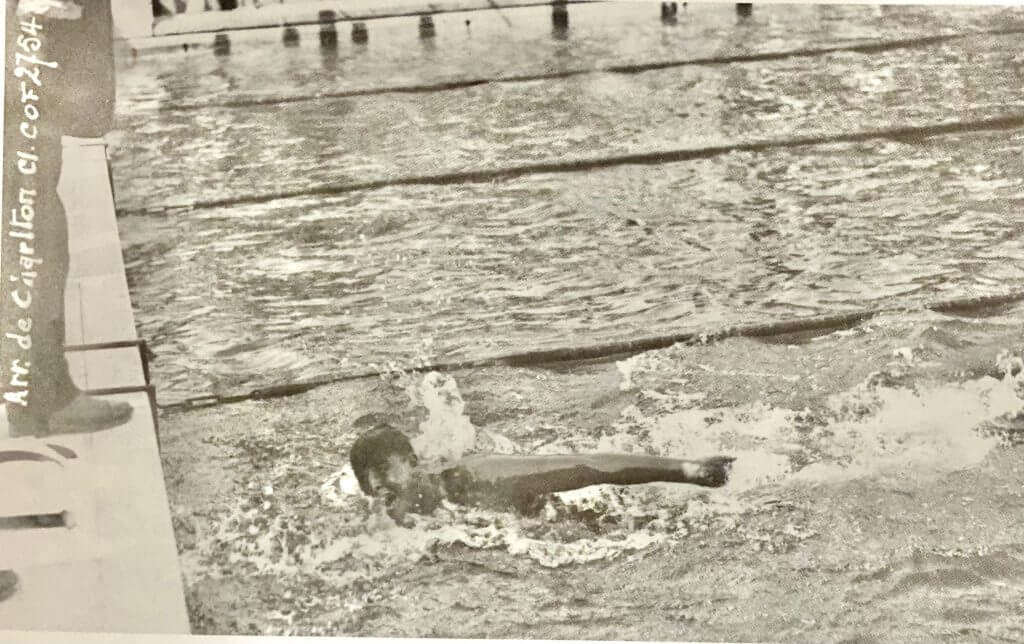
Australia’s Historic Manly Swimming Club Celebrates 100 Years of Olympic Dreams – To Paris And Back From 1924 to 2024.
Manly Swimming Club, one of Australia’s oldest and most distinguished swimming clubs, will this Saturday night host a sell-out Gala Dinner to celebrate 100 Years of Olympic Dreams – to Paris and back from 1924 to 2024.
A glittering trip down swimming’s memory lanes at the beachside Manly Pacific Hotel with a gathering of over 200 people celebrating the centenary of the 1924 Paris Olympics and the influence that Manly’s northern beaches region and its athletes have played in creating significant sporting pathways.
“It’s all about celebrating the past, honouring our present and planning for the future,” said Manly Swimming Club president, Matthew Patterson, the driving force behind the centenary celebration.
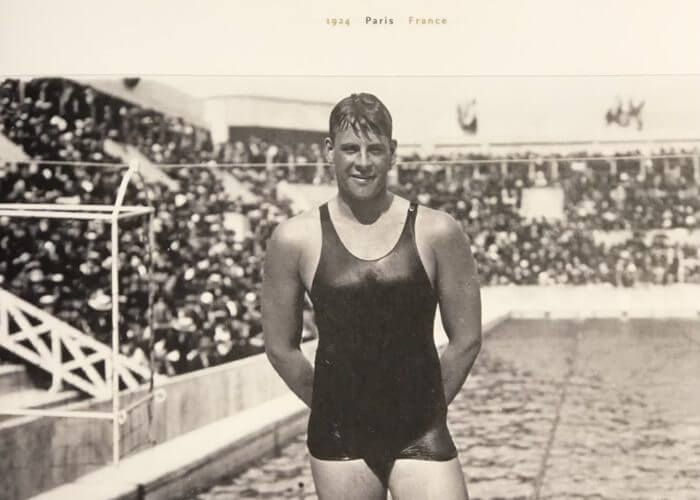
AUSTRALIA SENDS BOY WHO DOES A MAN’S JOB: Andrew “Boy” Charlton, Paris 1924 Olympic champion at 17, Photo Courtesy Official History Australian Olympic Committee:Harry Gordon
The 1924 Paris Games is hugely significant to the Manly Swimming Club as its very own legend, Andrew “Boy” Charlton triumphed to Olympic gold in the 1500m freestyle – one of Australia’s greatest ever Olympic feats from a boy who turned just 17 on the eve of the swimming competition, celebrating with a world record in his Olympic debut in the heats of the 1500m freestyle.
Dispelling doubts that he had struggled to maintain his form and fitness in a disrupted lead up to the Games, as author of “They Called Him Boy” the late Peter Fenton wrote: “Though reserved by nature he was extremely confident in knowing exactly what he had to do. Still a boy out of the water, he was a man in it.”
Charlton had announced himself to the swimming world at just 15 years of age in the Sydney summer of 1922-23 when he won the NSW State half-mile championship – 19 seconds inside the world record.
He later defeated “The Swedish Sturgeon” the great Arne Borg – the man regarded as the world greatest middle-distance and distance swimmer over 440 yards at Sydney’s Domain Baths (later christened the Andrew “Boy” Charlton Baths) – in front of more than 7000 people in a series of match races in that summer) a period that captured the imagination of the harbour city like nothing before.
“Boy” then surviving a long and traumatic 50-day journey via boat and train to Paris from Sydney to become Australia’s third individual Olympic swimming gold medallist – joining Freddie Lane (200m freestyle; 200m obstacles; Paris 1900) and Fanny Durack (100m freestyle; Stockholm 1912).
It was a memorable Games for Manly, a club established in 1903, with Charlton also winning 400m freestyle bronze in a race for the ages, before also joining another Manly teenager, his best friend, Ernest Henry in the silver-medal winning Australian 4x200m freestyle that finished second behind the star-studded US team, led by the legendary five-time Olympic gold medallist, he of Tarzan fame, Johnny Weissmuller.

HIGH FLYER: Olympic 10m Platform champion Dick Eve at6 the Paris 1924 Olympics. Photo Courtesy IOC Archives Lausanne.
Manly also celebrated gold to Richmond “Dick” Eve in the 10m Platform Diving – Eve’s father Sid, the proprietor of the Manly Baths and home of the Manly Swimming Club – while Manly fireman Nick Winter won Australia’s third gold – the first ever field gold medal in the hop, step and jump (triple jump).
“We have actually tracked down the relatives of Ernest Henry and Dick Eve who will be attending on the night and both families very excited and who will also bring down some precious medals and memorabilia that play such a significant part in our history,” said Patterson.
Adding to the Manly connection was the Australian Olympic Team’s manager Ossie Merrett, secretary of the Australian Olympic Federation, a Manly local and Manly Swimming Club and Manly Rugby Club secretary along with Charlton’s mentor and trainer, World War I veteran Tommy Adrian (travelling with the team as Charlton’s mentor) who suffered a breakdown on the voyage to Paris, in one of the most dramatic chapters in the colourful Australian Olympic history.
It is significant in the Manly Swimming Club annals to recall just how Charlton’s feats were documented (along with his record breaking with split times) in the club’s official 1923-24 Annual Report, written so formally by the Hon. Race Secretary (and how history remembers it) with the foresight to record the events of the time.
Of course, this followed the many stories published in the Australian and international press, heralding a swimmer with the notoriety of Australian cricketing great Don Bradman and later his fellow Olympic swimming legends Dawn Fraser and Ian Thorpe.
Charlton, a true superstar of the 1920s – a time without television and limited radio (that only began in 1923 and 1924), that relied on a cable service and newspaper reports read by an adoring sports-loving public, some five years after the horrors of the great War.
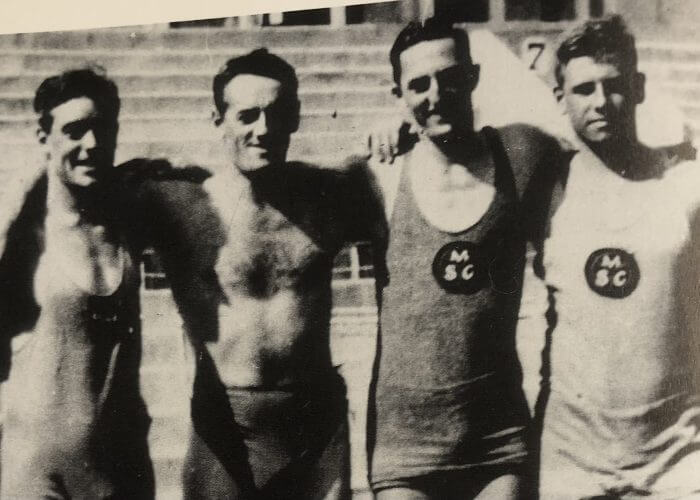
MANLY BOYS IN PARIS: Australian swim team members (L-R) Moss Christie, Ivan Stedman, Ernest Henry AND Andrew “Boy” Charlton. Photo Courtesy Henry Family Collection
This is the report written by the Hon. Race Secretary for the Manly Swimming Club’s 1923-24 Annual Report.
VIII OLYMPIAD, 1924
“The swimming events were held at the Tourelles Baths, during July 1924, a standard 50m bath!
“Our first representative to compete was A. M. (“Boy”) Charlton, in the 1500m Olympic championship in which his chief opponent was Arne Borg, the formidable Swede, whom he vanquished with comparative ease, winning in the world’s record time of 20mins 06 3-5secs., which lowered Borg’s WR, created in the heats, by 64 ½ secs and also lowered his own heat time (the previous WR) by 74 1/5secs.
“The result of this event was awaited with intense excitement, and although to sustain the high hope entertained by him, it could not have been reasonably accepted, that he would establish such a phenomenal time.
“This performance classes A. M (“Boy”) Charlton, as the greatest distance swimmer in the annals of swimming and it would be interesting to know just what he is capable of if extended!
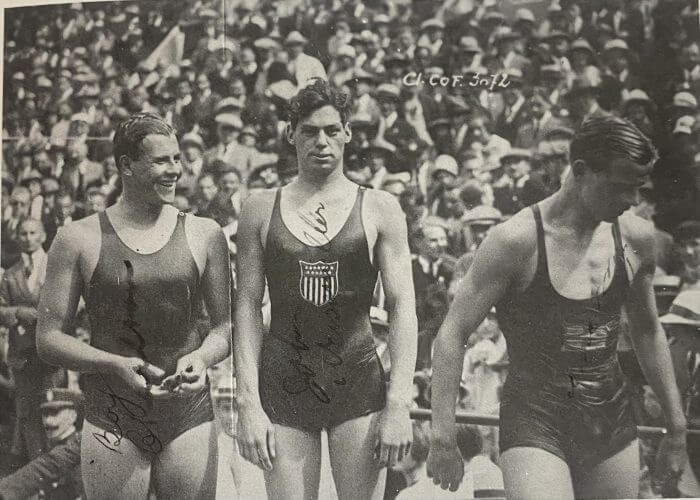
FRENCH CONNECTION: Paris Olympic 400m freestyle medallists (L-R) “Bo”y Charlton (Aus Bronze), Johnny Weissmuller (USA Gold) and Arne Borg (SWE silver). Photo Courtesy Lanes Of Gold (Swimming NSW).
“Prior to the Olympic Games the world’s record for 1500m stood to the credit of Borg, at 21 mins 35 3/10secs., which Charlton reduced by 15sec., in the heats, doing the distance in 21 mins. 20 3/10secs.
“The following heat created a sensation when Borg regained the ownership of the world’s record by cutting 8 9/10secs., off Charlton’s time – the record then stood at 21mins.11 2/5secs.
“Charlton’s time in the final however astounded the world.
“He swam the first 400m in 5mins 8 2/5secs., creating a new Olympic record and broke the world’s record for 1000m by 40 5/10secs., the new time being 13mins 19 4/5secs.
“Borg previously held the world record for 1000 metres at 14mins. 3/10secs.
“Although defeated by Weissmuller and Borg in the 400m freestyle Olympic Championship, it must be remembered that Charlton accomplished all that was asked of him by winning the 1500m in such convincing style.
“The meeting of these three world’s champions was the greatest event ever contested in the annals of swimming.
“The time for this race was 5mins 4 1/5secs., which is considerably outside Weissmuller’s own world record of 4mins 57secs., accomplished in a 25 yards bath.
“Borg’s time was 5mins. 5 3/5secs., and Charlton’s 5mins 6 3/5secs., which indicates how evenly matched these three great champions were.”
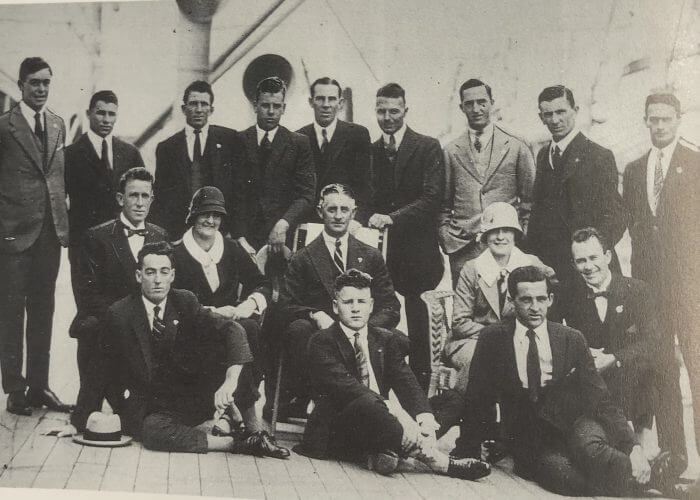
Members of the 1924 Australian Olympic Team on board the RMS Ormonde. Andrew “Boy” Charlton (back row, fourth from left). Photo Courtsey ES Marks Collection:Mitchell Library (AUS)
It is fitting that the Paris Olympics of 2024 – 100 years after Charlton, Borg and Weissmuller ruled the Tourelle Baths, that Paris will again be the centre of the sporting world with so much focus on the swimming events and the 400m freestyles for men and women with the world record of 3 minutes 40 seconds milestone very much in the sights of a stacked men’s field.
While the women’s 400m freestyle continues with the “Race of the Century” status, building up to one of the most long-awaited Olympic swimming races in history – between 2020 Olympic champion and world record holder, Australia’s own Ariarne Titmus, the world’s greatest female freestyler, former world record holder Katie Ledecky from the US and Canadian superstar and previous world record holder Summer McIntosh
It is also interesting to note that the modern multi-pool. Manly Aquatic Centre that is now the home of the Manly Swimming Club is named in the honour of Andrew “Boy” Charlton and its construction was a result of the destruction by storm and tempest of the original Manly Ocean Baths in 1974.
The club will also honour its current team with their kit emblazoned with the same club logo as the class of 1924 when they represent Manly at this year’s Australian Olympic Trials in Brisbane from June 10-15.Maintaining that special connection with some of Manly and Australia’s greatest swimming champions……and their own Olympic dreams some 100 years on…
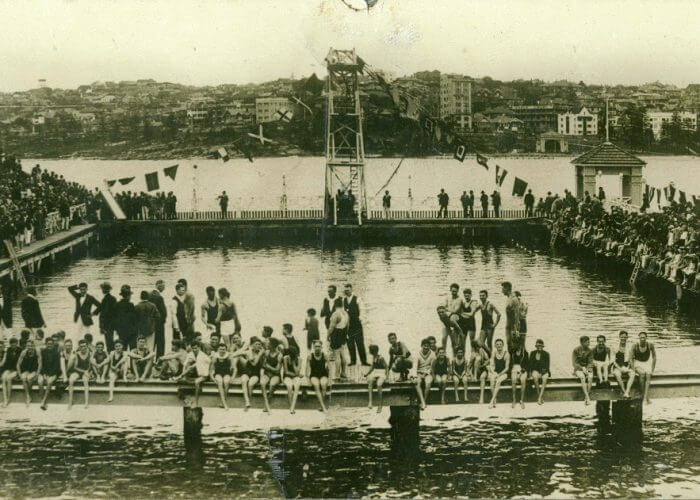
THE WAY WE WERE: Manly Baths in 1926,

THE WAY WE ARE: Andrew Boy Charlton Aquatic Centre, Manly 2024
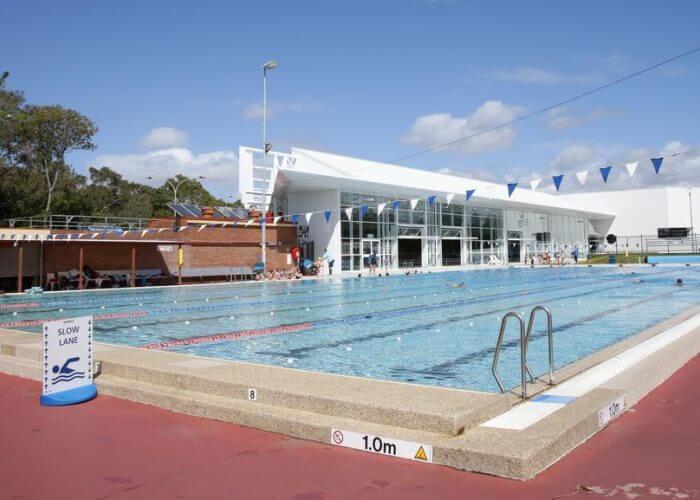
Andrew Boy Charlton Aquatic Centre Outdoor Pool.




Beautifully presented Ian! Thank you!
Historically significant indeed.